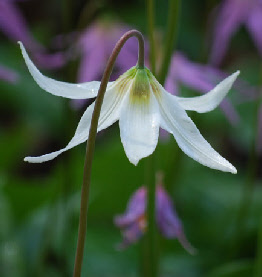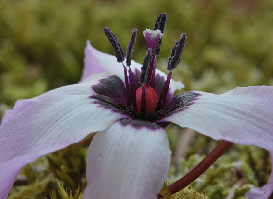
/
Erythronium
Considered by many to be the most beautiful, and of the easiest culture in most gardens,
are the lowland species (or hybrids of them) that come from the west side of the
Cascade Mountains -
The common name ‘Dog Tooth Violet’’ (though they are not at all related to violets) refers to the shape of the narrow bulb, in which some see similarities to the shape of a canine tooth. The bulbs (sometimes referred to as corms, but they are, botanically, true bulbs) are somewhat fragile and lack the protective skin that covers the more commonly fall planted bulbs like tulips or daffodils. This leaves them more susceptible to drying out. They need careful handling and should be planted as soon as possible on arrival in well drained, humus rich soil, in light shade. They are lovely interplanted with ferns, hostas, Solomon Seals, and other later emerging shade loving plants. They are excellent companions to trilliums and other ephemeral woodland plants. Once established they are long lived, pulling themselves deeper into the soil, and getting better each year, with some clones and hybrids forming very showy clumps. Others will just seed around and naturalize, finding the niches they like the most, doing your designing for you.
CULTURE: Plant the fragile bulbs carefully in well drained humus rich soil in light shade, a few inches under the surface. They will pull themselves deeper over time and are quite long lived. Top dress with compost yearly and/or give some organic fertilizer for larger, stronger clumps .
Hardiness: Unless indicated otherwise, they have all been proven hardy to at least zone 5b.

Erythronium revolutum
Erythronium toulumense
Fawn lilies, Trout Lilies, Dog Tooth Violets, whatever you choose to call them (I
prefer the imagery of ‘Fawn Lily’, referring here to the lovely mottled markings
on the leaves of some species) these little lily relatives are some of the most charming
spring flowering bulbs you can grow. They look like small nodding lilies, from 6”
to over 18” tall, with basal strap-
Erythronium hendersonii -



Erythronium oreganum
Collector's Nursery,16804 NE102nd Ave, Battle Ground, WA 98604, 360-





